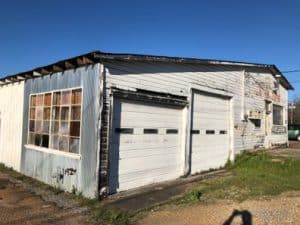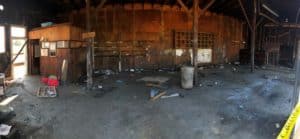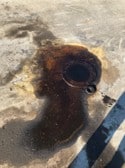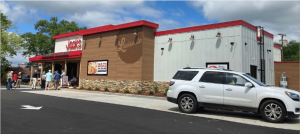 Contributed by Trey Hess P.E., Brownfield Redevelopment Director, PPM Consultants
Contributed by Trey Hess P.E., Brownfield Redevelopment Director, PPM Consultants
Redeveloping abandoned and contaminated properties—known as brownfields—into thriving commercial centers is no easy feat. It requires vision, coordination, financial ingenuity, and an understanding of market dynamics. In Louisville, Mississippi, the transformation of the long-abandoned Team Motors site into a vibrant Jack’s Family Restaurant is a compelling example of how blending market analysis with financial incentives can ignite community revitalization.
This story is not just about the cleanup of an environmentally challenged site—it is a blueprint for how cities can turn their liabilities into assets by applying thoughtful strategy, leveraging policy, and partnering with experts.
Understanding the Trade Area: The Bedrock of Smart Development
Before any redevelopment project can begin, especially one targeting commercial or retail outcomes, it is critical to define the local trade area. A retail trade area is the geographic region from which a town attracts most of its customers. It forms the basis for analyzing retail trends, estimating sales potential, and making informed decisions about where and how to invest.
Several approaches help define trade areas:
- Traffic Flow Analysis: Observing vehicle license plates in key parking areas over time reveals customer origins.
- Commuting Patterns: Mapping commuting times can help visualize how far people travel for work, a proxy for how far they might travel for goods.
- Reilly’s Law of Retail Gravitation: This mathematical model calculates how far people will travel to shop based on community size and distance.
- Zip Code Analysis: Using customer ZIP codes from sales records helps delineate retail reach.
Understanding the trade area allows communities and developers to estimate the total market size by combining population density and average travel distances. It also helps identify retail gaps or “leakage” where residents are shopping outside of town, signaling opportunities for new businesses.
Why This Matters
Analyzing the trade area and recognizing the potential customer base beyond city limits made it clear that a strong quick-service restaurant could thrive. While the city’s population might not appear large enough on its own to support major development, its trade area told a different story—one of untapped potential and retail draw.
Market Viability in Brownfield Redevelopment
Market viability is the cornerstone of successful brownfield redevelopment. Key factors in assessing a brownfield site’s market potential include:
- Demographics: Population size, growth trends, and income levels.
- Proximity to Infrastructure: Roads, utilities, and other public services.
- Local Market Demand: Gaps in existing retail or service offerings.
- Regulatory Landscape: Zoning, incentives, and cleanup requirements.
Brownfields are often located in core urban areas or along primary corridors, which positions them well for redevelopment. However, without addressing the environmental liability and cost burden, these properties remain dormant.
This is where incentives play a transformative role.
MERA: Mississippi’s Strategic Incentive for Brownfield Redevelopment
The Mississippi Economic Redevelopment Act (MERA) is one of the most innovative tools available for brownfield projects. MERA allows developers to receive tax rebates from sales, income, and franchise taxes generated within a designated redevelopment area. Over a period of up to 15 years, developers can be reimbursed up to 2.5 times the amount they spend on environmental cleanup.
Key Features of MERA:
- Up to 150% return on remediation investment
- Reimbursement over 15 years
- Utilizes collected state taxes within the redevelopment zone
- Applies to a broad range of project types: commercial, retail, industrial, and mixed-use
This incentive significantly lowers the financial risk of remediating contaminated properties. Developers who once shied away from brownfield projects are now more willing to invest, knowing they can recover their costs through state-supported tax rebates.
 The Louisville Case Study: Turning Contamination into Community Value
The Louisville Case Study: Turning Contamination into Community Value
The Team Motors site in downtown Louisville had long been a visible reminder of urban decay. The property was a patchwork of former uses: a mechanic shop, a gas station, a petroleum bulk terminal, and an antique store. Years of operations left behind a host of environmental concerns: petroleum hydrocarbons, chlorinated solvents, asbestos, and the threat of vapor intrusion.
In 2019, PPM Consultants conducted Phase I and Phase II Environmental Site Assessments (ESAs), followed by a Phase III in 2020, all funded through the City of Louisville’s Brownfield Assessment Grant, which served as a competitive advantage over other communities vying for retail redevelopers. The findings were significant but not insurmountable.
Jack’s Enters the Picture
Around this time, Jack’s Family Restaurants, LP expressed interest in the property. However, the company was understandably hesitant due to the liabilities and expected remediation costs.
That’s when the City of Louisville, the Winston County Partnership, and the property owner called on PPM Consultants to help design a path forward.
 PPM facilitated:
PPM facilitated:
- Brownfield Agreement and Liability Protections through MDEQ
- Site Assessment & Cleanup Planning using funds from the City’s EPA Brownfield Assessment Grant
- Design of a Vapor Barrier beneath the proposed restaurant
- Installation of an Ozone Sparging Groundwater Cleanup System
- MERA Application Support to secure tax rebates for cleanup costs
Through this collaboration, Jack’s moved forward with construction of a 3,700-square-foot restaurant in the heart of Louisville. This was the first brownfield redevelopment project in Mississippi to use a vapor barrier to mitigate vapor intrusion, marking a milestone in innovative remediation practices.
Economic Impact: Beyond Bricks and Mortar
 The redevelopment had immediate and long-term benefits:
The redevelopment had immediate and long-term benefits:
- $2.25 million in private investment
- Up to 45 permanent jobs, including as many as 4 managerial positions
- Annual payroll of approximately $500,000
- 30 construction jobs during the build phase
But the economic benefits ripple outward. Using the trade area capture and pull factor models, analysts can measure how many customers are attracted from outside the immediate area and how that spending benefits the local economy.
For example, if Louisville’s population is 6,500, and the new restaurant serves 12,000 customer equivalents based on retail sales, the city is effectively drawing significant economic activity from surrounding communities—a strong indicator of a well-placed development.
A Public-Private Partnership That Worked
The success of this redevelopment hinged on collaboration:
- EPA and Mississippi Department of Environmental Quality (MDEQ) provided oversight and regulatory support.
- The City of Louisville and the Winston County Partnership championed the effort.
- PPM Consultants provided technical, regulatory, and financial guidance.
- Jack’s Family Restaurants brought private investment, jobs, and energy to the project.
This integrated approach exemplifies how different entities can come together to achieve a shared vision of revitalization.
Lessons for Other Communities
- Know Your Market
Defining and understanding your retail trade area is not a theoretical exercise—it directly informs what kinds of developments will succeed. Communities that conduct trade area and retail gap analysis can attract the right kinds of businesses to meet local and regional demand.
- Use the Tools Available
Programs like MERA are often underutilized because developers and municipalities aren’t aware of them or don’t know how to navigate the process. That’s where consultants like PPM play a vital role.
- Think Long-Term
Brownfield redevelopment is not just about eliminating blight. It’s about setting the stage for long-term economic growth. Investments in cleanup and infrastructure pay dividends for years, from job creation to rising property values.
- Build the Right Team
From environmental engineers to economic developers to city officials, the right partnerships make all the difference. PPM’s role was not just technical; it was also about connecting the dots between opportunity, funding, and execution.
 Conclusion: Blight Into Opportunity
Conclusion: Blight Into Opportunity
Louisville’s success shows that brownfield redevelopment isn’t just possible—it’s powerful. It combines environmental stewardship with economic development, leveraging public and private resources for the greater good. And it all starts with understanding where your customers are and what your community needs.
At PPM Consultants, we specialize in turning brownfields into business opportunities. Through tools like MERA, EPA grants, and decades of experience, we help communities and developers write their own success stories.
The Jack’s project in Louisville is one such story—from a contaminated, idle property to a bustling restaurant employing dozens and serving thousands. With the right vision, partners, and tools, any community can go from blight to boom.

